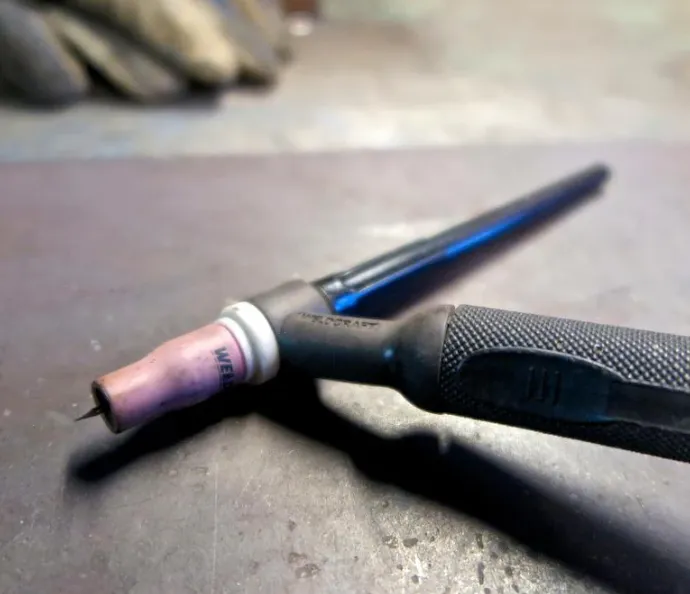When it comes to robotic welding, choosing the right torch is essential for ensuring optimal performance and long-term productivity. One key decision involves selecting between air-cooled and water-cooled welding torches. Understanding the advantages and limitations of each will help you make an informed choice that aligns with your production needs and goals. In this post, we’ll break down the differences between these two options, so you can make the best decision for your operations.
Water-Cooled Welding Torches: High Performance for Continuous Operation
Water-cooled welding torches rely on a cooling solution that circulates through the torch, absorbing heat from the welding process. This setup allows the torch to operate at higher amperages for longer periods without overheating. The water circulation keeps the torch and its consumables cooler, which reduces heat buildup and minimizes the risk of damage, making it an ideal choice for demanding welding applications.
One of the key benefits of water-cooled torches is their ability to handle continuous, high-temperature operations. These torches are often used in situations where prolonged, high-amperage welding is required. Depending on the amperage load, water-cooled torches can return to a cooled state in as little as 30 seconds to two minutes, thanks to their efficient cooling system.
However, water-cooled torches are typically more expensive due to the additional equipment required, such as water coolers, hoses, and pumps. The initial investment and maintenance costs are higher than air-cooled systems, but the performance benefits can justify the added expense in high-demand environments.
Air-Cooled Welding Torches: Simplicity and Durability
In contrast, air-cooled welding torches use ambient air and shielding gas to dissipate heat, making them simpler and more rugged. These torches often feature thicker copper cabling that helps transfer electricity efficiently while preventing excessive heat buildup in the cables.
Air-cooled torches are favored for their ease of maintenance. Since the torch package is located outside the robot arm, it’s easier to access and repair when needed. Additionally, because they don’t require extra cooling systems, there’s less equipment to worry about, which can reduce the chances of damage during a collision or other impacts.
These torches are also more portable, making them ideal for remote job sites where water is not easily accessible. While they can handle a variety of applications, air-cooled torches are typically best for lower-amperage tasks and short-duty-cycle jobs.
Factors to Consider When Choosing Between Air-Cooled and Water-Cooled Torches
Amperage and Duty Cycle
When deciding between air-cooled and water-cooled torches, your amperage requirements are one of the most important factors to consider. Water-cooled torches typically handle higher amperages (300–600 amps), making them ideal for jobs that require continuous high-amperage welding. For example, tasks such as welding at 800 amps over long periods demand a water-cooled system, as air-cooled models may struggle to maintain performance under these conditions.
On the other hand, air-cooled torches are best suited for lower-amperage applications (150–600 amps) and jobs with lower duty cycles. If your work involves welding lighter materials or operating intermittently, an air-cooled torch is likely sufficient and more cost-effective.
Worksite Location and Portability
If your operations take place in remote locations where water availability is limited, an air-cooled torch is the more practical option. Air-cooled systems are self-contained and portable, making them easy to transport from site to site. In contrast, water-cooled torches require additional equipment like hoses and coolers, which take up more space and are less convenient for mobile or temporary installations.
Material and Gas Mixture
The material you’re working with also plays a role in your torch selection. Water-cooled torches excel with shiny metals like aluminum or thicker materials that require consistent high heat. If you’re welding thinner materials or need to operate in tight spaces, an air-cooled torch may be more suitable.
Additionally, the type of shielding gas mixture can affect the torch’s performance. For example, CO2 mixed with other gases like argon or helium may lower the torch’s amperage capacity, so it’s important to consider how the gas mixture interacts with your welding process.
Cost Considerations
Water-cooled torches come with higher upfront costs due to the additional cooling equipment required. You’ll need to purchase components like a radiator, pump, and hoses. Furthermore, maintenance costs for water-cooled systems can be more expensive because of the additional parts and equipment.
While air-cooled torches have a lower initial cost, they also have limitations in terms of performance, especially for high-amperage or continuous-duty applications. However, the simplicity and durability of air-cooled torches make them a great option for less demanding welding tasks and reduce the likelihood of costly repairs.
Conclusion: Choosing the Right Torch for Your Welding Needs
The choice between air-cooled and water-cooled welding torches depends on your specific welding requirements. Water-cooled torches are ideal for high-amperage, long-duty-cycle tasks, providing superior cooling and performance. They’re best suited for environments where continuous, high-quality welding is needed. On the other hand, air-cooled torches are simpler, more portable, and better for low-amperage, short-duty-cycle jobs.
By carefully considering factors such as amperage, duty cycle, worksite location, material type, and cost, you can make the right decision for your welding process. Ultimately, selecting the correct torch will help optimize your production efficiency and ensure consistent, high-quality results on every weld.







